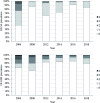Mass eradication of Helicobacter pylori to reduce gastric cancer incidence and mortality: a long-term cohort study on Matsu Islands
- PMID: 32792335
- PMCID: PMC7815911
- DOI: 10.1136/gutjnl-2020-322200
Mass eradication of Helicobacter pylori to reduce gastric cancer incidence and mortality: a long-term cohort study on Matsu Islands
Abstract
Objective: Although mass eradication of Helicobacter pylori has been proposed as a means to eliminate gastric cancer, its long-term effects remain unclear.
Design: Mass eradication of H. pylori infection was launched in 2004 and continued until 2018 for a high-risk Taiwanese population aged 30 years or older dwelling on Matsu Islands with prevalent H. pylori infection. Test positives for the 13C-urea breath test underwent eradication therapy. We evaluated the effectiveness of the mass eradication in reducing two main outcomes, incidence and mortality rates of gastric cancer, until the end of 2016 and 2018, respectively.
Results: After six rounds of mass screening and eradication, the coverage rate reached 85.5% (6512/7616). The referral rate for treatment was 93.5% (4286/4584). The prevalence rates of H. pylori fell from 64.2% to 15.0% with reinfection rates of less than 1% per person-year. The presence and severity of atrophic gastritis and intestinal metaplasia also decreased with time. Compared with the historical control period from 1995 to 2003, the effectiveness in reducing gastric cancer incidence and mortality during the chemoprevention period was 53% (95% CI 30% to 69%, p<0.001) and 25% (95% CI -14% to 51%, p=0.18), respectively. No significant changes were noted in the incidence rates of other digestive tract cancers or the antibiotic resistance rate of H. pylori.
Conclusion: Population-based eradication of H. pylori has significantly reduced gastric cancer incidence with no increase in the likelihood of adverse consequences. A significant reduction in mortality is likely to be achieved with a longer follow-up period.
Trial registration number: NCT00155389.
Keywords: cancer prevention; gastric cancer; helicobacter pylori.
© Author(s) (or their employer(s)) 2021. Re-use permitted under CC BY-NC. No commercial re-use. See rights and permissions. Published by BMJ.
Conflict of interest statement
Competing interests: DYG is a consultant for RedHill Biopharma and Phathom Pharmaceuticals regarding novel H. pylori therapies and has received research support for culture of Helicobacter pylori. The rest authors have no conflicts of interest.
Figures





References
-
- Bray F, Ferlay J, Soerjomataram I, et al. . GLOBOCAN estimates of incidence and mortality worldwide for 36 cancers in 185 countries. CA Cancer J Clin 2018;2018:394–424. - PubMed
-
- Tan MC, Balakrishnan M, Graham DY. Gastric cancer worldwide except Japan : Shiotani A, Gastric cancer with special focus on studies from Japan. Singapore: Springer, 2018: 17–28.
-
- IARC Helicobacter pylori Working Group (2014) Helicobacter pylori Eradication as a Strategy for Gastric Cancer Prevention. Lyon, France: International Agency for Research on Cancer (IARC Working Group Reports, No. 8). Available: http://publications.iarc.fr/Book-And-Report-Series/Iarc-Working-Group-Re... [Accessed 6 Aug 2019].
Publication types
MeSH terms
Substances
Associated data
LinkOut - more resources
Full Text Sources
Medical
